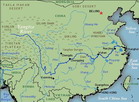2020 Yangtze River Cruise and Ferry Starting from 79 USD p.p.!
The Yangtze River's Source
 From
the bitter cold and treeless Alps of Upper Qinghai,
around the source of the Yangtze, the snow that
gradually melts in the summer sun trickles down
the beds of Ancient glaciers,and finally reaches
the pastures where man and beast can survive.
The snowmelt forms small streams which sing
through the tilted plateaus and nourish the
grassroots and the hardy little flowers and
plants that the Local Tibetan People use as
medicine for a variety of ills.
From
the bitter cold and treeless Alps of Upper Qinghai,
around the source of the Yangtze, the snow that
gradually melts in the summer sun trickles down
the beds of Ancient glaciers,and finally reaches
the pastures where man and beast can survive.
The snowmelt forms small streams which sing
through the tilted plateaus and nourish the
grassroots and the hardy little flowers and
plants that the Local Tibetan People use as
medicine for a variety of ills.
The streams flow more swiftly down
the lower Qinghai Mountains, which give an impression
of Central Europe. On successive steps of mountain
and plateau, the People of the Yushu Tibetan
Autonomous District cultivate barley and shelter
the Herds in winter, sending them up to the
high pastures only in spring. Their diet Consists
of meat, milk (fresh and fermented), and arley-meal,
which is the staple. Sometimes they add sugar
brought from distant parts of China. And in
the forest belts they cut timber for the construction
of new towns.
The ubiquitous yak is the most usefu1
beast, but sheep are reared for meat and Wool
and there are some goats. The tough, shaggy
little ponies of the mountains are used as a
means of transport, and mares' milk is a treasured
delicacy and cure-all.
Animal husbandry is the main occupation
of these Tibetans and they continue to lead
a semi-nomadic life, living in thick black yak-hair
tents lined with bags of Precious bar1ey, and
surrounded by their grazing flocks. For several
days each spring the people gather together
to sing, dance, hold horse races and tugs of
war, before Again returning to their lives of
isolation.
The streams turn to sizeable rivers
as they come down to the 3,000-metre (l0, 000-Foot)
level or thereabouts. Typically they flow blue
and wide across valley floors Where the barley
is now fairly abundant and small villages-decorated
with the inevitable Buddhist prayer flags-take
the place of tent encampments. Despite their
deep poverty, the women dress gaily in black
and a rainbow of decorative co1ours, plaiting
their hair Almost like Africans, and wearing
it in braids, sometimes interwoven with red
cord. To commemorate special religious festivals,
pilgrimages are made to monasteries (Often many
days' riding away) for they are social as well
as religious occasions.
The wildlife is abundant-Tibetan
antelopes, Mongolian gazelles, snow leopards,
Otters, martens, lynxes and deer, as well as
dozens of species of birds. Carp throng the
cold waters of the lakes. Nature reserves are
being established to protect the Beautiful and
threatened snow leopard and the primeval forests
in which the wild ass And the snow cock still
roam.
At over 5,000 meters (16,400jeet)
sheep graze near the tongue of one of the Glaciers
whose melt waters feed the upper Tuotuohe in
western Qinghai Province on the border with
Tibet. For several years this river was considered
to be the source of the Yangtze.



